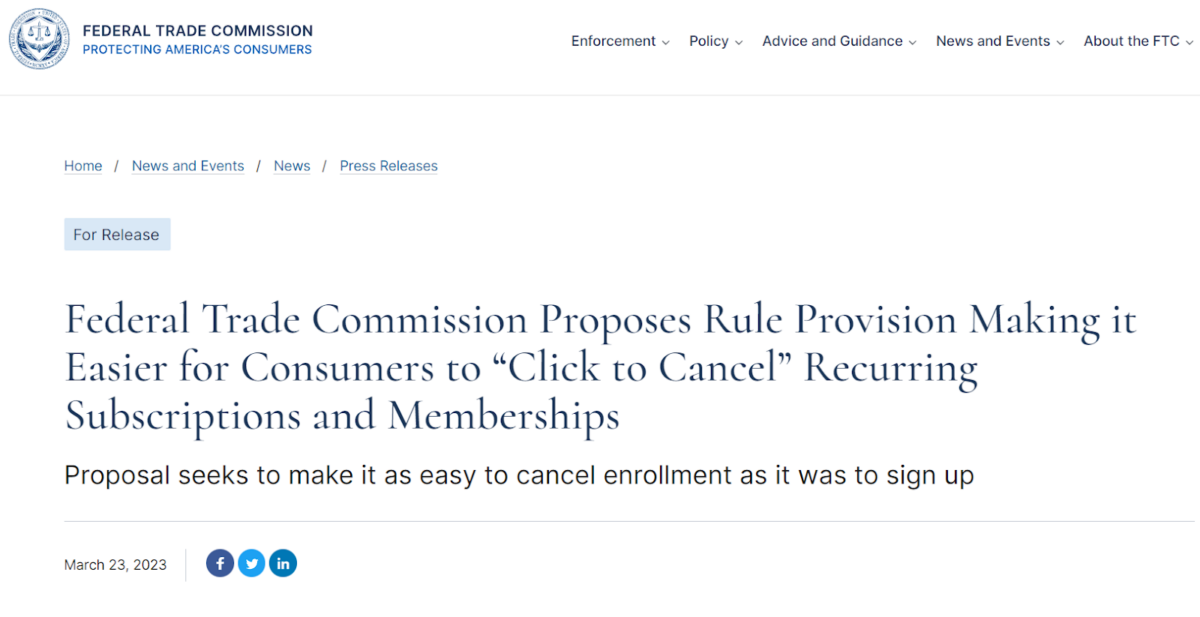
FTC continues to solicit comments on click-to-cancel button and other proposed revisions to its Negative Option Rule
We have all felt the frustration of having to jump through hoops to cancel a recurring monthly subscription. Fortunately, the FTC is in the process of potentially removing hurdles to canceling by updating its Negative Option Rule. The rule essentially says that if a consumer has not taken action to stop a subscription, that serves as consent for continued billing. Long overdue for a modern update, the 1973 law, when established, pertained mostly to relics like book-of-the-month and record-of-the-month clubs.
The FTC is accepting comments until June 23 with proposed changes including:
- Mandatory “click to cancel” buttons on emails and/or webpages.
- A requirement that if you signed up for a subscription online, there is an option to unsubscribe on the same website.
- A requirement that if a company wants to extend a counteroffer to an unsubscribing consumer, it needs the consumer’s consent before proceeding with the promotions. In other words, the company needs to take no for an answer.
- A requirement that companies send a reminder that you will soon be billed for an annual subscription renewal.
The regulations have the potential to benefit consumers, stamp out bad corporate practices and ultimately, increase the proliferation of subscription boxes as consumers gain confidence they will be able to cancel as they wish. I once subscribed to the CBS streaming service in order to watch a game and, after an arduous cancellation process, vowed never to watch CBS again. For CPG companies, added consumer confidence in subscription services could be a boon for grocery delivery and parcel carriers. The CPG items that are ideal for subscription services are bulky, consumable items that households do not want to run out of, such as dog food.
Pre-rolled cones are the new 6-pack for the canna-curious

On Monday’s The Stockout, I interviewed Bryan Gerber, CEO and co-founder of Hemper and HARA Brands, which produces and sells cannabis smoking accessories through retailers, directly to consumers, and through their flagship subscription boxes. Gerber also made a name for himself selling massive volumes of pre-rolled cones, a convenience item for newfound cannabis users, which he compares to grabbing a 6-pack of beer on the way home.
Among highlights that pertain to other CPGs looking to sell directly to consumer either a la carte or via subscription boxes:
- Inflation has put more pressure on subscription box sales than a la carte sales.
- Companies should solicit feedback on the subscription boxes from the subscribers — those dedicated customers are usually eager to sound off to improve future boxes.
- Data collected from sales on your website should be used to demonstrate to retailers which products will sell.
- Subscription boxes should include innovative, proprietary products that cannot be found elsewhere (at least for a window of time) or customer engagement will wane.
- Companies need to be more focused on keeping current subscribers than on marketing to new customers — word of mouth will be your best salesperson.
- Customers should be able to customize their subscription box even if it means somewhat lower overall economies of scale in sourcing — auto-generation of subscription box content is not effective.
- Venture capital has largely dried up for cannabis startups as investors have shifted focus to demanding that portfolio companies show profitability.
See full interview here.
FreightWaves writers highlight demand pressure
In the past week, FreightWaves published two articles directly related to CPG. JP Hampstead described how freight brokers are seeing volume declines, even in the areas of food/beverage, and other CPG, which normally provide a stable source of volume for 3PLs. Plus, packaging expert Adam Josephson highlighted yet another source of transportation demand weakness — the idling of a major containerboard mill.
Here are a few takeaways from the articles:
- Shippers are placing a higher priority on service than they have in the past and imposing severe penalties on suppliers and carriers for noncompliance.
- Shippers are slowing the pace at which they put freight out to bid, which suggests they are looking to lock in savings in freight rates and may suggest they think the market is close to a bottom.
- High inventory levels in some categories have made transportation less time sensitive, and some shippers have responded by consolidating shipments into full truckloads to save freight costs.
- Echo Global Logistics is an example of a 3PL that is looking to differentiate itself to shippers needing temperature-controlled services, such as food and beverage companies, by purchasing real assets, such as cold chain warehousing facilities.
- Demand from the three largest North American containerboard/box producers declined from 8%-13% in Q1.
- Packaging Corp. is indefinitely idling one of its seven containerboard mills, calling into question bullish comments it made on its April 25 analyst call that is had seen a “big turnaround” starting in April.
To subscribe to The Stockout, FreightWaves’ CPG supply chain newsletter, click here.







